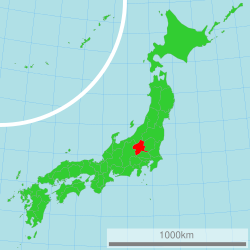Gunma Prefecture
|
Gunma Prefecture 群馬県 |
|||
|---|---|---|---|
| Prefecture | |||
| Japanese transcription(s) | |||
| • Japanese | 群馬県 | ||
| • Rōmaji | Gunma-ken | ||
|
|||
 |
|||
| Country | Japan | ||
| Region | Kantō | ||
| Island | Honshu | ||
| Capital | Maebashi | ||
| Government | |||
| • Governor | Masaaki Osawa | ||
| Area | |||
| • Total | 6,362.33 km2 (2,456.51 sq mi) | ||
| Area rank | 21st | ||
| Population (May 1, 2015) | |||
| • Total | 1,971,195 | ||
| • Rank | 19th | ||
| • Density | 310/km2 (800/sq mi) | ||
| ISO 3166 code | JP-10 | ||
| Districts | 7 | ||
| Municipalities | 35 | ||
| Flower | Japanese azalea (Rhododendron japonicum) | ||
| Tree | Japanese black pine (Pinus thunbergii) | ||
| Bird | Copper pheasant (Phasianus soemmerringii) | ||
| Fish | Sweetfish (Plecoglossus altivelis) | ||
| Website | www.pref.gunma.jp | ||
Gunma Prefecture (群馬県 Gunma-ken?) is a prefecture of Japan located in the northwest corner of the Kantō region on the main Honshu island. Its capital is Maebashi.
Japan was without horses until around the fifth century CE. The ancient province of Gunma was a center of the horsebreeding and trading activities for the newly immigrated continental peoples. The arrival of horses and the remains of horse-tackle coincides with the arrival of a large migration from the mainland. From this point forward, the horse became a vital part of Japanese military maneuvers, quickly displacing the older Yayoi tradition of fighting on foot.
When Mount Haruna erupted in the late 6th century, Japan was still in the pre-historical phase (prior to the importation of the Chinese writing system during the Nara period). The Gunma Prefectural archaeology unit in 1994 was able to date the eruption through zoological anthropology at the corral sites that were buried in ash.
In the past, Gunma was joined with and called Kenu Province. This was later divided into Kami-tsu-ke (Upper Kenu, Gunma) and Shimo-tsu-ke (Lower Kenu, Tochigi). The area is sometimes referred to as Jomo (上毛, Jōmō). For most of Japanese history, Gunma was known as the province of Kozuke.
In the early period of contact between western nations and Japan, particularly the late Tokugawa, it was referred to by foreigners as the "Joushu States", inside (fudai, or loyalist) Tokugawa retainers and the Tokugawa family symbol is widely seen at public buildings, temples and shrines.
The first modern silk factories were built with Italian and French assistance at Annaka in the 1870s.
In the early Meiji period, in what was locally called the Gunma Incident of 1884, a bloody struggle between the idealistic democratic westernizers and the conservative Prussian-model nationalists took place in Gunma and neighboring Nagano. The modern Japanese army gunned down farmers with new repeating rifles built in Japan. The farmers in Gunma were said to be the first victims of the Murata rifle.
...
Wikipedia


